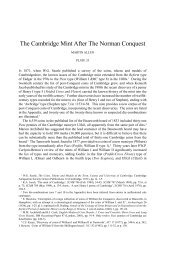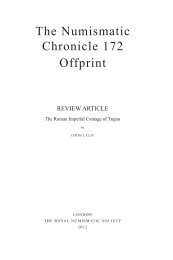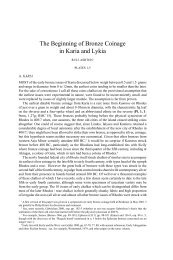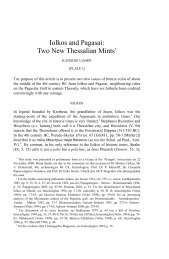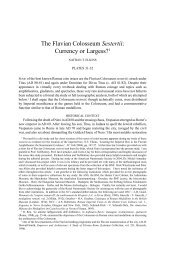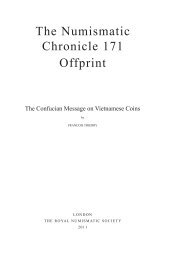The Numismatic Chronicle 171 Offprint - Royal Numismatic Society
The Numismatic Chronicle 171 Offprint - Royal Numismatic Society
The Numismatic Chronicle 171 Offprint - Royal Numismatic Society
You also want an ePaper? Increase the reach of your titles
YUMPU automatically turns print PDFs into web optimized ePapers that Google loves.
ROMAN REPUBLICAN STAR BRONZES, RRC 113 AND 196 101<br />
Neither Grueber nor Sydenham 2 distinguish the issues but rather gather all star<br />
coins together, Sydenham as his catalogue number 264, Grueber as Rome 461-<br />
469. Interestingly Grueber describes the BM quadrantes as ‘exceptionally light<br />
weight’ (3.5 to 5g). He lists in footnotes several varieties which are not in the British<br />
Museum. 3<br />
Two other numismatists have looked at the series, Santini and Zehnacker. 4<br />
Santini reproduces d’Ailly’s arrangement with the addition of further examples. He<br />
admits that the classifi cation presents many diffi culties, such are the irregularities<br />
and inconsistencies of the series, probably stemming from differences in mints and<br />
periods. He repeats the basic classifi cation of the asses into one recognisably goodstyle<br />
main issue (RRC 113/2), and other issues (RRC 196/1). As for the fractions,<br />
the conclusion that the many star-before quadrantes are of lighter weight confi rms<br />
the general classifi cation, but is reinforced by the fact that star-before trientes are<br />
also of lighter weight. So he again supports the classifi cation suggested by d’Ailly.<br />
Zehnacker, while considering the silver in great depth, defers again to d’Ailly on<br />
bronzes, but compounds the misunderstanding of the bronze issues by including<br />
line-drawings of imaginary asses with star before or star under prow and using them<br />
to discuss matters of style.<br />
None of these numismatists commented on the specifi c technical details of the<br />
reverse design, which provide the solution to the classifi cation dilemma.<br />
2. Features of proper RRC 113 asses and semisses (Period 1 style)<br />
As mentioned above, the two denominations that can be classifi ed without diffi culty<br />
are the asses and semisses. <strong>The</strong> following features are present consistently in all<br />
examples of RRC 113 (Figs 1, 2 above and Fig. 5 below):<br />
Reverse:<br />
1. Prow-stem is straight, long and slim.<br />
2. Two close lower wales (horizontal lines above keel but below the mid-wale<br />
line of dots) curve down and, from left to right, converge toward keel.<br />
3. Wales meet in a short rostrum tridens which projects, if at all, only a little past<br />
the hull.<br />
4. <strong>The</strong> A in ROM_ is open, i.e. the bar of the A is angled and is connected to only<br />
one of the two vertical supports of the letter.<br />
Obverse:<br />
5. Stern, regular, uniform features<br />
6. Beards made mostly of tufts<br />
<strong>The</strong> same features occur on the semisses.<br />
2 H. Grueber, Coins of the Roman Republic in the British Museum (London, 1910, repr. 1970); E.<br />
Sydenham, <strong>The</strong> Coinage of the Roman Republic (London, 1952).<br />
3 Grueber, op. cit., p. 55 note 2.<br />
4 A. Santini, Saggio di catalogo generale della monete consolari anonime con simboli (Milan, 1939);<br />
H. Zehnacker, Moneta : recherches sur l’organisation et l’art des émissions monétaires de la République<br />
romaine (289-31 av. J. C.) (Rome, 1973).



